Basil is a versatile herb that not only adds flavor to dishes but also offers numerous benefits as a companion plant in the garden. With its fragrant aroma and beautiful foliage, basil is not only a culinary delight but a valuable ally in creating a thriving and sustainable garden. In this article, I’ll explore the concept of companion gardening with basil and highlight its many benefits. From repelling pests to enhancing soil nutrients, basil can truly be a gardener’s best friend.
What is Companion Planting?
Companion planting is an ancient, time-tested practice of growing different plants together to promote a healthy and productive garden. By strategically pairing plants, you can take advantage of their natural characteristics to improve pest control, soil fertility, and overall plant growth. Companion planting with basil involves selecting specific plants that complement its attributes and create a harmonious garden ecosystem.
Repel Pests and Protect Your Crops
Basil’s strong aroma and natural compounds make it an excellent companion for repelling pests. By planting basil alongside susceptible crops, you can deter unwanted insects and protect your harvest. Some common pests that basil can repel include cabbage worms, carrot flies, cucumber beetles, Mexican bean beetles, and cabbage moths. By incorporating basil into your garden, you can create a natural barrier against these damaging pests.
Enhance Soil Nutrients
Companion planting with basil can also enhance soil nutrients. Certain plants, like bush or pole beans, have the ability to fix nitrogen in the soil, replenishing this essential nutrient for other plants. By interplanting basil with nitrogen-demanding crops, you can improve the overall health of your garden and promote robust growth.
Attract Beneficial Insects
Basil’s flowers are a magnet for beneficial insects, such as bees and ladybugs, which play a crucial role in pollination and pest control. By planting basil in close proximity to your crops, you can attract these valuable pollinators and predatory insects. This not only supports a healthy garden ecosystem but also ensures better yields and reduced pest populations.
Improve Taste and Growth
Companion planting with basil can improve the taste and growth of neighboring plants. Basil releases chemicals that can accelerate vegetable growth and enhance their flavor. By planting basil alongside vegetables like tomatoes, peppers, and eggplants, you can enjoy more flavorful and abundant harvests.
Provide Shade and Keep Soil Cool
Taller plants and those with dense foliage, like zucchini and asparagus, can provide shade for sun-sensitive plants in the garden. Basil’s compact size and bushy growth make it an ideal companion for these taller plants, helping to create a microclimate that keeps the soil cool and preserves moisture.
Natural Weed Control
Companion planting with basil can also help suppress weeds and minimize competition for nutrients and space. By planting basil close to other crops, you can create a dense planting arrangement that leaves little room for weeds to grow. This not only saves time and effort in weed management but also ensures that your plants have access to essential resources.
How to Companion Plant with Basil
Successfully companion planting with basil requires careful planning and consideration. Researching plant compatibility and understanding the growth habits of different plants is essential. When companion planting with basil, ensure that your plants have enough space to grow without overcrowding each other. Consider factors such as sunlight requirements, nutrient needs, and the mature size of each plant. By following these guidelines, you can create a harmonious garden with basil as a versatile companion.
Basil’s Best Plant Partners
When it comes to companion planting with basil, certain plants make excellent partners. Tomatoes, potatoes, asparagus, garlic, peppers, root vegetables, marigolds, borage, chives, oregano, and chamomile are just a few examples of plants that thrive when planted alongside basil. These companions enhance each other’s attributes and contribute to a flourishing garden ecosystem.
Tips for Successful Companion Planting
Here are some additional tips to ensure successful companion planting:
- Plant tall crops on the north side of the garden and low-growing crops on the south side to ensure adequate sunlight for all plants.
- Group plants with similar nutrient needs together to optimize growth and health.
- Plant herbs and flowers with vegetables to deter pests and attract beneficial insects.
- Research plant compatibility and avoid planting incompatible plants near each other.
- Consider the mature size and growth habits of each plant to prevent overcrowding.
Conclusion
Basil is not only a flavorful herb but also a valuable companion plant in the garden. Its benefits extend beyond culinary use, as it can repel pests, enhance soil nutrients, attract beneficial insects, improve taste and growth, provide shade, and suppress weeds. By understanding the principles of companion planting and selecting compatible plants, you can create a thriving and sustainable garden. So, why not harness the power of basil’s companionship and experience the rewards of companion gardening?
Companion Planting: Maximizing Benefits for a Healthy and Productive Garden
Companion planting is a gardening practice that involves growing different plants together to maximize their benefits and promote a healthy and productive garden. By strategically pairing plants based on their compatibility and complementary characteristics, gardeners can create a harmonious ecosystem that supports plant growth, deters pests, attracts beneficial insects, and improves overall garden health.
One of the key benefits of companion planting is pest control. Certain plants naturally repel pests, while others attract beneficial insects that prey on garden pests. For example, planting basil near tomatoes can help deter thrips and disrupt the habits of tomato hornworm-causing moths. Similarly, marigolds planted with tomatoes can repel aphids, making it an effective natural pest control strategy. By incorporating plants with pest-repellent properties into your garden, you can reduce the need for chemical pesticides and create a more sustainable and environmentally-friendly garden.
Another advantage of companion planting is improved soil fertility. Some plants, such as legumes like beans and peas, have the ability to fix nitrogen from the air and convert it into a form that other plants can easily absorb. By interplanting nitrogen-fixing plants with nutrient-demanding crops, you can replenish soil nutrients and promote healthier plant growth. Additionally, plants with deep roots, like dill and fennel, can help break up compacted soil, improve drainage, and increase nutrient availability for neighboring plants.
Benefits of Companion Planting:
- Enhanced pest control through natural repellent properties
- Improved soil fertility and nutrient availability
- Attracted beneficial insects for pollination and pest control
- Reduced reliance on chemical pesticides
- Increased biodiversity and ecological resilience
In addition to pest control and soil improvement, companion planting can also enhance plant growth and flavor. Some plants release chemicals that stimulate the growth and flavor of neighboring vegetables. For example, basil, chamomile, and marjoram can accelerate vegetable growth and improve flavor when planted nearby. By carefully selecting compatible plants that can enhance each other’s growth, you can achieve more abundant and flavorful harvests.
Companion planting also offers practical benefits, such as providing shade and conserving moisture in the garden. Tall plants like corn or trellised crops can create shade for sun-sensitive plants, helping to regulate soil temperature and reduce water evaporation. Additionally, ground-covering companion plants like oregano can help suppress weeds, minimizing competition for nutrients and creating a more manageable garden environment.
Companion planting is an age-old technique that partners two or more plants together with the goal of providing specific benefits for one or more of those plants.
| Companion Plant | Benefits |
|---|---|
| Basil | Repels pests and improves flavor and growth of neighboring plants |
| Marigolds | Repels aphids and other common garden pests |
| Dill | Attracts beneficial insects and improves soil fertility |
| Nasturtiums | Repels pests and attracts pollinators |
| Mint | Repels aphids, ants, and flea beetles |
When practicing companion planting, it’s important to consider plant compatibility, spacing, and growth habits. Researching which plants thrive together and planning your garden layout accordingly can greatly increase the success of companion planting. Additionally, making use of diverse companion plant combinations can create a more resilient and robust garden ecosystem.
Companion planting is a versatile and sustainable gardening technique that can benefit both novice and experienced gardeners. By harnessing the power of plant relationships, gardeners can create a thriving garden that is not only visually appealing but also productive and environmentally-friendly.

Repel Pests and Protect Your Crops
Basil’s aromatic properties make it an excellent companion plant for repelling pests and safeguarding your crops from destructive insects. By strategically planting basil alongside your other garden plants, you can create a natural barrier that deters pests and helps protect your valuable crops.
One of the key benefits of companion planting with basil is its ability to repel a variety of pests. Basil’s strong fragrance acts as a natural deterrent for insects such as aphids, mosquitoes, flies, and mites. These pests are known to cause damage to plants by feeding on their leaves or transmitting diseases.
When basil is planted near susceptible crops, its scent can confuse and repel pests, preventing them from causing harm. For example, planting basil alongside tomatoes can help deter tomato hornworms and protect the fruit from damage.
Additionally, basil has been found to repel pests such as cabbage moths and cucumber beetles, which are common threats to cabbage, broccoli, and cucumber plants. By interplanting basil with these crops, you can help safeguard them from infestations and reduce the need for chemical pesticides.
Companion planting with basil can also attract beneficial insects that prey on garden pests. For example, basil attracts ladybugs, lacewings, and parasitic wasps, which are natural predators of aphids, caterpillars, and other destructive insects. These beneficial insects help control pest populations, maintaining a healthy balance in your garden ecosystem.
To maximize the benefits of basil as a pest repellent, it’s important to plant it strategically. Consider placing basil plants throughout your garden, especially near crops that are susceptible to pest damage. This will create a barrier effect, making it more difficult for pests to reach your valuable plants.
When interplanting basil with other crops, make sure to provide adequate spacing to allow each plant to thrive. Ensure that the basil plants do not overshadow or overcrowd neighboring plants, as this can inhibit their growth and development.
Quote:
“Companion planting with basil is a natural and effective way to repel pests and protect your crops. By harnessing the power of basil’s aromatic properties, you can create a garden ecosystem that is inhospitable to destructive insects, reducing the need for chemical pesticides and promoting a healthier environment for your plants.”
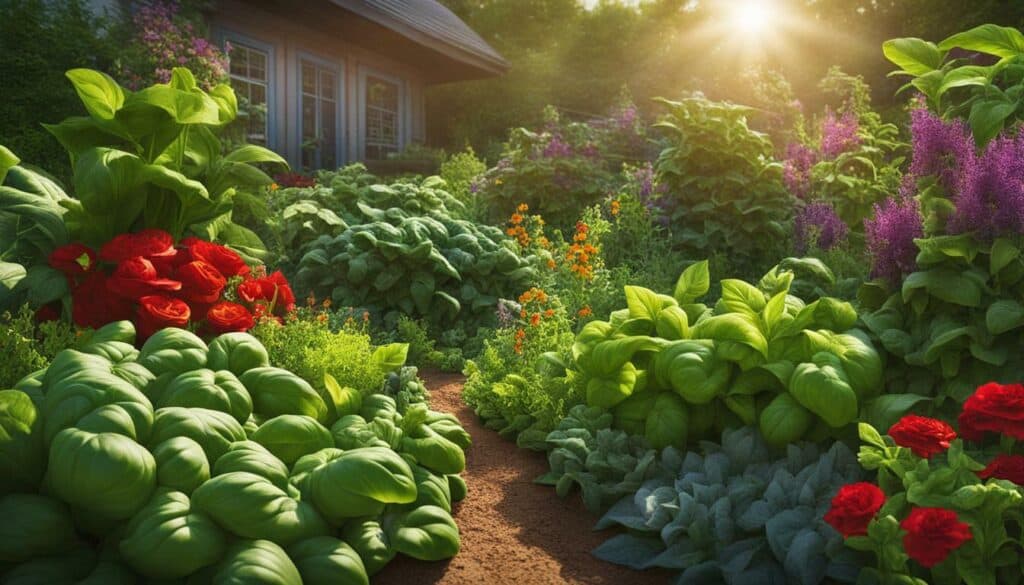
In addition to repelling pests, companion planting with basil offers other benefits such as enhancing soil nutrients, attracting beneficial insects, improving taste and growth, providing shade, and controlling weeds. By incorporating basil into your garden as a companion plant, you can create a thriving and sustainable ecosystem that supports the health and productivity of your crops.
Next, we’ll explore how companion planting with basil can help replenish soil nutrients and improve the overall health of your garden.
Replenish Soil Nutrients with Basil and Companion Plants
Basil, along with certain companion plants, can contribute to the replenishment of essential soil nutrients, ensuring optimal plant growth and productivity. When planning your garden, it’s important to consider the nutrient needs of different plants and how they can benefit from companion planting with basil.
Companion planting with basil helps create a diverse and balanced ecosystem in the garden. Here are some ways in which basil and its companions can enhance soil nutrients:
- Nitrogen Fixation: One of the key benefits of companion planting with basil is its ability to fix nitrogen in the soil. Nitrogen is an essential nutrient for plant growth and is often depleted in the soil due to the demands of heavy-feeders like tomatoes and peppers. By planting nitrogen-fixing plants like beans or peas alongside basil, you can replenish nitrogen levels naturally, providing a nutrient boost to neighboring crops.
- Mulching and Decomposition: Basil leaves can be used as a natural mulch around plants, helping to retain moisture in the soil and prevent weed growth. As the leaves break down, they release nutrients back into the soil, enriching it with organic matter and improving its overall fertility.
- Composting: Basil trimmings and leftover plants can be used as valuable additions to your compost pile. As they decompose, they contribute to nutrient-rich compost that can be added back to the garden soil, providing a sustainable source of nutrients for your plants.
By incorporating companion plants that replenish soil nutrients, such as basil and nitrogen-fixing plants, you can create a more self-sustaining garden system. This reduces the need for synthetic fertilizers and promotes a healthier, more nutrient-rich soil environment.
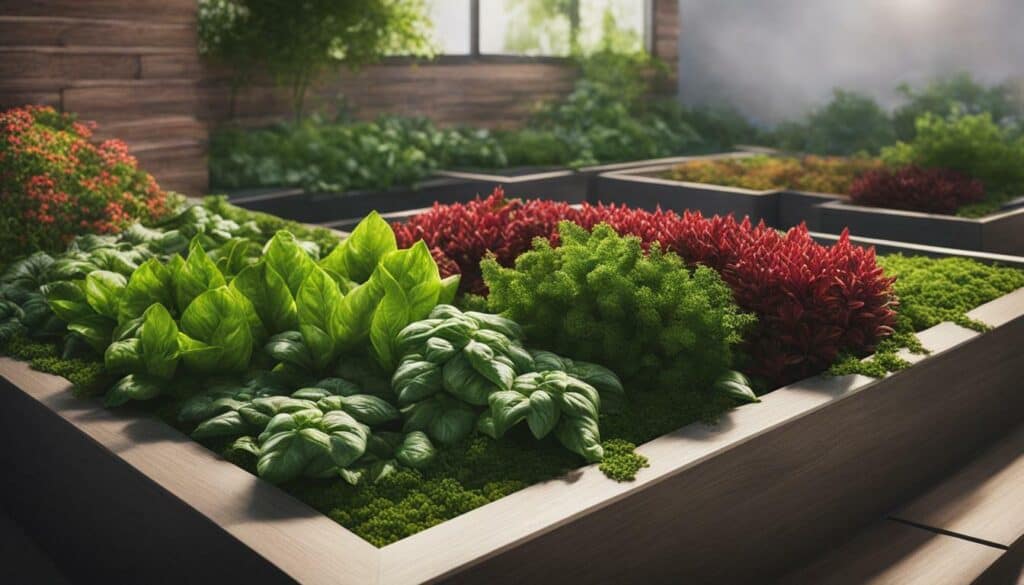
“Companion planting with basil helps create a diverse and balanced ecosystem in the garden.”
In addition to basil, other companion plants can also play a role in enhancing soil nutrients. For example, legumes like beans and peas have the ability to fix nitrogen in the soil. Their roots form a symbiotic relationship with nitrogen-fixing bacteria, which convert atmospheric nitrogen into a usable form for plants. When these legumes are grown alongside basil, the nitrogen they provide can benefit not only basil but also other nearby plants.
Furthermore, plants with deep taproots, such as comfrey or dandelions, can help bring up nutrients from deeper layers of the soil and make them available to shallower-rooted plants like basil. Their extensive root systems can access nutrients that may be inaccessible to other plants, effectively mining the soil and improving its overall nutrient content.
When companion planting with basil and other nutrient-enhancing plants, it’s important to consider compatibility and growth habits. Some plants may compete for resources or have different pH requirements, so it’s important to research and choose companion plants that are mutually beneficial and compatible with basil.
By incorporating companion planting strategies that focus on replenishing soil nutrients, gardeners can create a more sustainable and productive garden. Basil, along with its companion plants, can contribute to healthier soil, increased nutrient availability, and improved plant growth and productivity.
Attract Beneficial Insects
By incorporating basil and other companion plants into your garden, you can create an inviting habitat for beneficial insects that contribute to pollination and natural pest control. These insects play a crucial role in maintaining a healthy and thriving garden ecosystem.
One of the key benefits of companion planting with basil is its ability to attract beneficial insects such as bees and ladybugs. The fragrant flowers of basil act as a beacon, drawing these important pollinators to your garden. Bees are essential for pollinating many types of plants, including fruits and vegetables. Ladybugs, on the other hand, are voracious predators of garden pests like aphids, mites, and scale insects.
By providing a food source and a safe haven for these beneficial insects, basil helps to ensure that your crops are adequately pollinated and protected from harmful pests. This can result in increased yields and healthier plants.
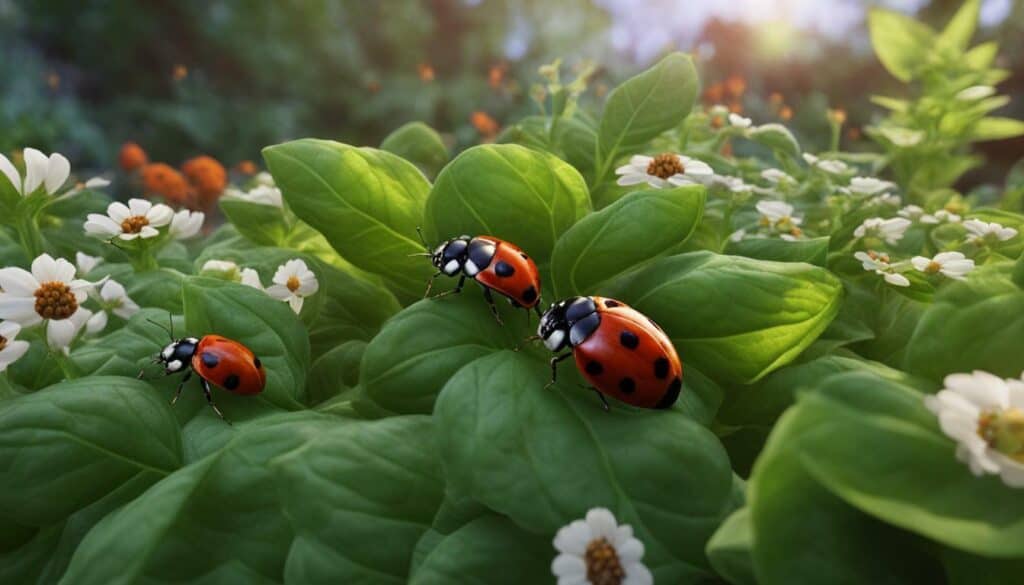
Companion planting with basil also benefits other plants in your garden by attracting a diverse range of pollinators. Different pollinators have different preferences when it comes to flower shape, size, and color. By planting a variety of companion plants alongside basil, you can create a colorful and enticing buffet of nectar and pollen sources for bees, butterflies, and other pollinators.
The presence of these pollinators not only improves fruit set and quality but also helps to promote genetic diversity in your garden. This can be particularly beneficial if you are saving seeds for future plantings.
Companion Plants for Pollinators:
Here are some companion plants that are known for their ability to attract beneficial insects, including pollinators:
| Companion Plant | Benefit |
|---|---|
| Sunflowers | Attracts a wide variety of pollinators with their large and vibrant flowers. |
| Marigolds | Attract bees, butterflies, and other beneficial insects while repelling certain pests. |
| Lavender | Attracts bees and butterflies with its fragrant purple flowers. |
| Zinnias | Offer a nectar-rich food source for bees, butterflies, and hummingbirds. |
| Nasturtiums | Attract beneficial insects and repel pests such as aphids and whiteflies. |
By including these companion plants in your garden alongside basil, you can create a diverse and attractive environment that supports a thriving population of pollinators and beneficial insects. This will not only benefit your garden but also contribute to the overall health and biodiversity of your local ecosystem.
“The presence of these pollinators not only improves fruit set and quality but also helps to promote genetic diversity in your garden.” – Gardening Enthusiast
Improve Taste and Growth
Basil releases certain chemicals that can enhance the taste and stimulate the growth of nearby vegetables, making it a valuable companion plant for flavor enhancement. When planted alongside other crops, basil can have a positive influence on their development, resulting in more robust and flavorful harvests.
Some of the best companion plants for improving taste and growth include:
| Companion Plant | Benefits |
|---|---|
| Chamomile | Chamomile releases compounds that improve the flavor of neighboring plants, including basil. It also has a calming effect on pests, reducing their damage to the garden. |
| Summer Savory | Summer savory stimulates the growth of nearby vegetables, including beans and onions. It also enhances their flavor, making them more delicious. |
| Marjoram | Marjoram has aromatic properties that help improve the taste of neighboring plants, such as tomatoes and peppers. It also attracts beneficial insects that aid in pollination and pest control. |
By strategically planting basil alongside these flavor-enhancing companions, you can create a flavorful and thriving garden. The combination of these plants not only improves taste but also contributes to a healthier and more productive harvest.
“Basil releases certain chemicals that can enhance the taste and stimulate the growth of nearby vegetables, making it a valuable companion plant for flavor enhancement.”
Remember, when companion planting for flavor enhancement, it’s essential to consider the growth habits and nutrient needs of the plants you are pairing. Pay attention to their compatibility and ensure they have enough space to grow without crowding each other out.
Additionally, incorporating herbs like basil among your vegetables not only improves taste but also adds visual interest to your garden. The vibrant green leaves of basil create a beautiful backdrop and elevate the overall aesthetics of your garden space.
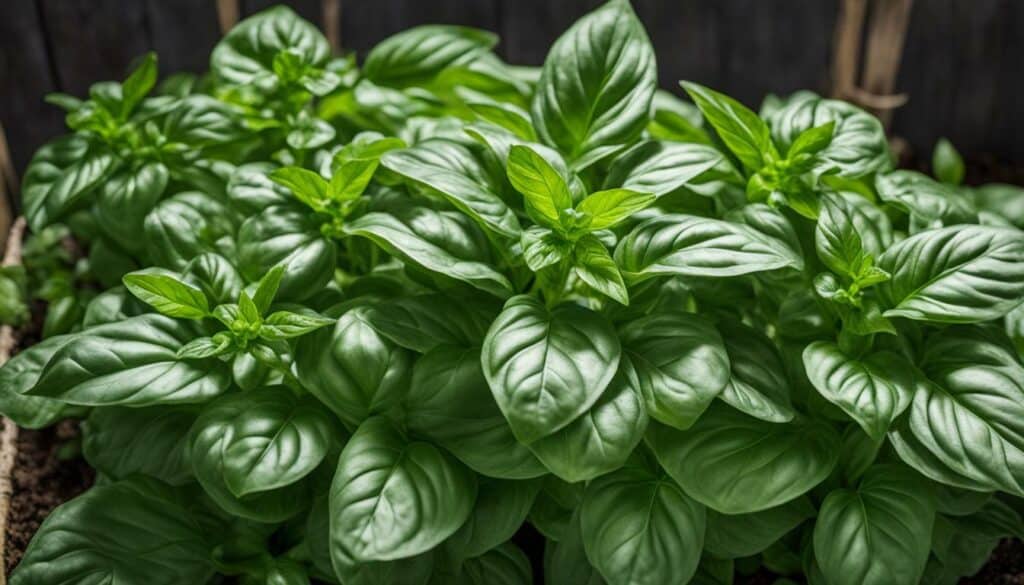
Companion planting with basil not only enhances the taste and growth of neighboring plants but also contributes to a harmonious and thriving garden ecosystem. By choosing the right companions and considering their compatibility, you can create a garden that delights both your taste buds and your eyes.
Taller companion plants, including basil, can provide shade and help regulate soil temperature, creating a favorable environment for sun-sensitive crops and preventing excessive moisture loss.
Companion planting is not only about improving pest control and nutrient absorption, but it can also play a significant role in creating a microclimate within your garden. Taller companion plants, like basil, can provide shade and help regulate soil temperature, ensuring the well-being of sun-sensitive crops and minimizing moisture loss.

When strategically planted, basil can serve as a natural shade provider and help create a cooler environment for neighboring plants. This is especially beneficial for crops that are prone to sunburn or heat stress, such as lettuce, spinach, and other leafy greens. By shielding these sun-sensitive plants from direct sunlight during the hottest parts of the day, basil helps maintain optimal growing conditions and prevents damage caused by excessive heat.
Furthermore, the shade provided by taller companion plants, like basil, can help regulate soil temperature. Excessive heat can lead to increased evaporation and moisture loss from the soil, which can be detrimental to the health and growth of your plants. By creating a protective canopy, basil helps conserve moisture and keeps the soil cool, contributing to a more stable and favorable growing environment.
In addition to shade and temperature regulation, basil can also contribute to moisture retention in the soil. Its dense foliage helps reduce water evaporation, keeping the soil moist for longer periods. This is particularly beneficial in arid or dry regions where water conservation is crucial for successful plant growth.
By incorporating basil as a companion plant in your garden, you can create an environment that promotes the well-being and productivity of sun-sensitive crops. The shade provided by basil helps regulate soil temperature, prevents excessive moisture loss, and contributes to a more favorable microclimate for your plants to thrive.
Keep Weeds Away with Companion Plants
Planting companion plants alongside your vegetables can act as a natural weed control method, reducing weed growth and allowing your crops to thrive without undue competition. By strategically choosing the right companion plants, you can create a harmonious garden ecosystem that minimizes weed pressure and maximizes the health and productivity of your plants.
The Benefits of Companion Plants for Weed Suppression
Companion plants can help suppress weeds in several ways. Some companion plants release chemicals into the soil that inhibit weed germination and growth. Others outcompete weeds for resources like light, water, and nutrients. Additionally, certain companion plants attract beneficial insects that feed on weed seeds and seedlings.
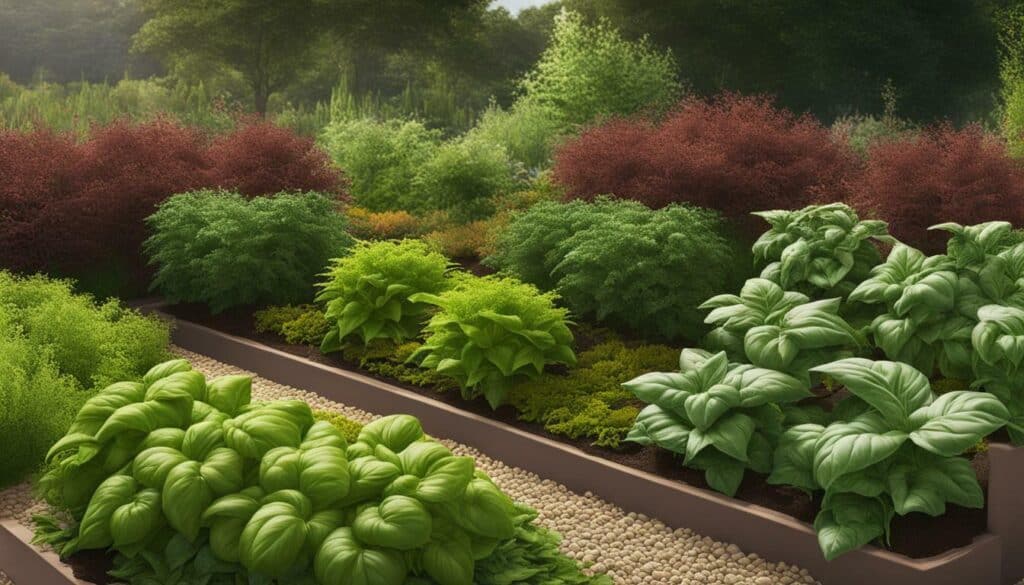
“Companion planting with certain plants can create a weed-suppressing environment in your garden.”
When it comes to weed suppression, one of the most effective companion plants is the humble marigold. Marigolds produce a natural chemical called alpha-terthienyl, which inhibits the growth of many common weeds. Planting marigolds throughout your vegetable garden can create a weed-suppressing environment, reducing the need for manual weeding.
Tips for Effective Weed Suppression
To make the most of companion plants for weed suppression, consider the following tips:
- Interplant companion plants throughout your vegetable garden, spacing them strategically to maximize coverage and minimize gaps where weeds can thrive.
- Choose companion plants that have dense foliage or a spreading growth habit to create a living mulch that shades the soil, preventing weed seed germination.
- Select companion plants that have allelopathic properties, meaning they release chemicals that inhibit weed growth.
- Create companion plant combinations that complement each other’s weed-suppressing abilities. For example, planting marigolds alongside a ground cover like clover can provide both chemical inhibition and physical smothering of weeds.
Companion Plant Combinations for Weed Suppression
Here are some popular companion plant combinations known for their weed-suppressing qualities:
| Companion Plant | Vegetable |
|---|---|
| Marigolds | Tomatoes, peppers, cucumbers |
| Clover | Squash, pumpkins, melons |
| Thyme | Carrots, onions, potatoes |
| Buckwheat | Cabbage, kale, broccoli |
| Chives | Lettuce, spinach, peas |
“Companion planting with marigolds, clover, thyme, buckwheat, and chives can help suppress weeds in your vegetable garden.”
By incorporating these companion plants into your garden, you can effectively reduce weed growth and create a healthier, more productive growing environment for your vegetables. Embrace the power of companion planting and say goodbye to unwanted weeds!
Companion Planting with Basil: Tips for Successful Companion Planting
Companion planting with basil requires careful planning and consideration of plant compatibility and proper placement to maximize the benefits for your garden. By strategically selecting and arranging companion plants, you can create a thriving and sustainable garden ecosystem. Here are some tips to help you succeed in companion planting with basil:
Research and Plan
Before starting your companion planting journey, it’s essential to do thorough research on which plants are compatible with basil. Different plants have varying needs and can either thrive or struggle when planted together. Consider factors such as sunlight requirements, soil pH, and nutrient requirements. A garden bed drawing with the names of all the plants you wish to include can help you stay organized and plan accordingly.
Proximity is Key
In companion planting, plants must be close to each other to benefit from their interactions. Companion plants are like friends – they get along and support each other. When planting, ensure that companion plants are in close proximity to basil for the best results. Arrange plants in a way that maximizes their beneficial effects, such as planting different herbs and flowers together to attract pollinators and beneficial predators.
Consider Plant Size
When companion planting, it’s crucial to consider the mature size of each plant. Ensure that your plants have enough space between them to flourish without crowding each other out for resources. This will prevent competition for nutrients, sunlight, and water, allowing each plant to thrive. Plant taller crops on the north side of the garden and low-growing crops on the south side to ensure that all plants receive adequate sunlight.
Plant Compatibility
Some plants make excellent companions for basil due to their complementary traits and interactions. Here are a few examples of basil’s best plant partners:
| Basil Companion Plants | Benefits |
|---|---|
| Tomatoes | Keep hornworms away from tomatoes and improve flavor |
| Peppers | Repel pests and enhance moisture retention |
| Eggplants | Deter thrips and reduce pest damage |
| Beans | Nitrogen fixation for improved soil fertility |
| Cabbage | Repel pests and deter cabbage moths and flies |
Additional Tips
Here are some additional tips to ensure successful companion planting with basil:
- Plant root vegetables, such as carrots and beets, near fast-growing vegetables like beans or peas to make the most of limited space.
- Plant herbs and flowers with vegetables to help deter pests in your garden. For example, planting marigolds near tomatoes helps to repel aphids.
- Group plants with similar nutrient needs together, such as cabbage and beets, which both require lots of nitrogen.
- Be aware of plants that don’t get along, such as tomatoes and potatoes, as they can weaken each other’s growth.
- Plant companion plants in clusters to enhance their beneficial effects, such as planting different herbs and flowers together to attract pollinators and beneficial predators.
By following these tips, you can create a harmonious garden ecosystem where basil and its companions thrive together. Companion planting with basil not only enhances the health and productivity of your garden but also adds beauty and variety to your outdoor space.
Basil’s Best Plant Partners
Basil has several plant partners that it thrives alongside, including tomatoes, potatoes, asparagus, garlic, peppers, root vegetables, marigolds, borage, and herbaceous plants like chives, oregano, and chamomile. These companion plants offer a range of benefits, from pest control to flavor enhancement. Let’s explore some of the best plant partners for basil and how they contribute to a thriving garden.
Tomatoes
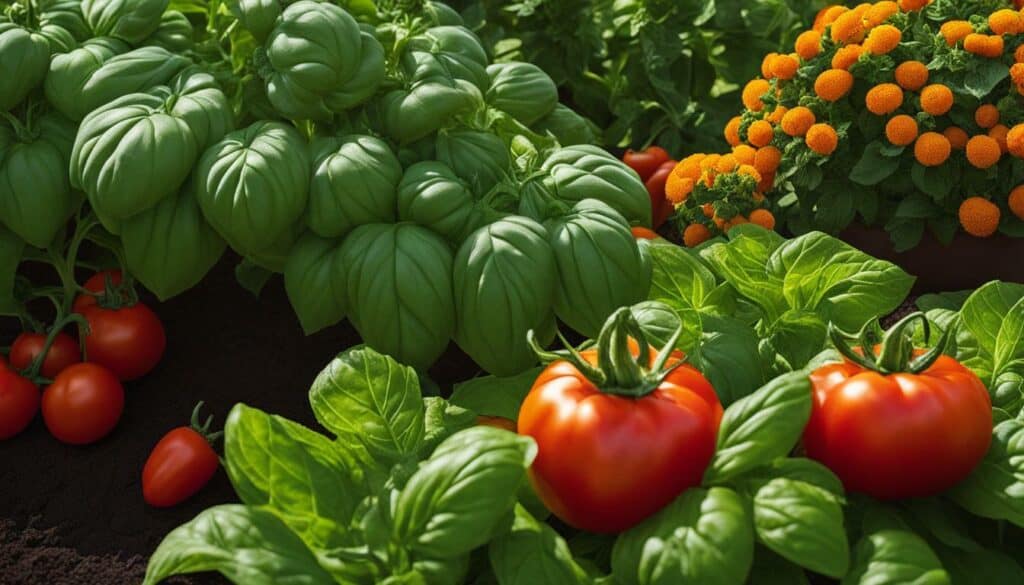
Tomatoes and basil are not only a winning combination in the kitchen, but they also make excellent companion plants in the garden. Basil helps deter pests like hornworms, which can cause damage to tomato plants. In return, tomatoes benefit from the aromatic presence of basil as it improves their growth and flavor.
Potatoes
Basil and potatoes are another great pairing in the garden. Basil helps improve the taste of potatoes and contributes to a healthy, bountiful harvest. Additionally, basil repels pests like the asparagus beetle, which commonly affects young asparagus shoots, providing protection for potato plants as well.
Asparagus
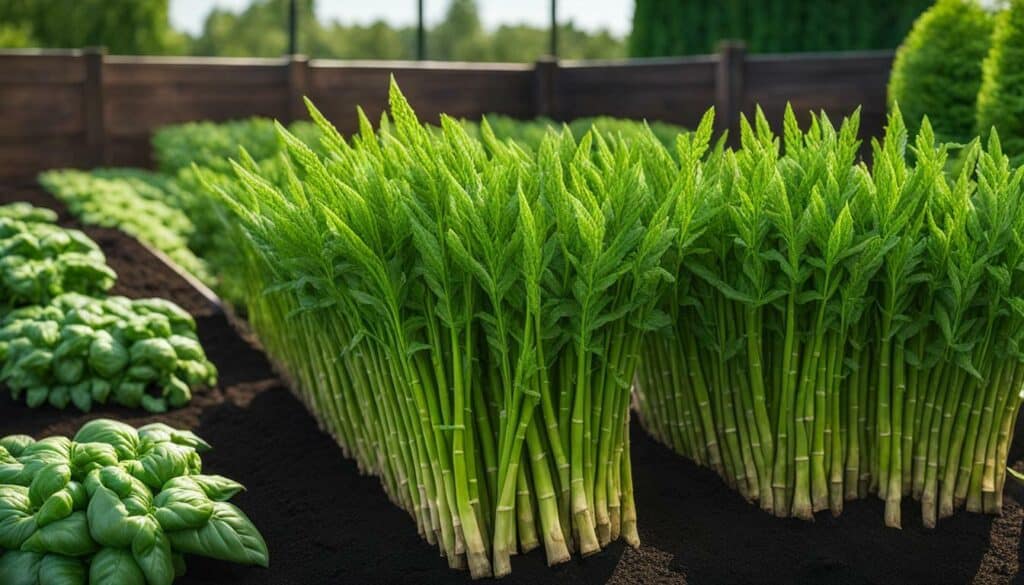
When basil and asparagus are planted together, they create a beneficial partnership. Basil attracts ladybugs, which are natural predators of pests that commonly attack asparagus. At the same time, basil acts as a repellent against the asparagus beetle, helping to protect the tender shoots of asparagus plants.
Garlic
Pairing basil with garlic not only enhances the flavor of both herbs but also improves their growth. Basil and garlic are close friends in the garden, as they help enhance each other’s flavor when planted nearby. This dynamic duo creates a robust and flavorful combination in your garden and culinary creations.
Peppers
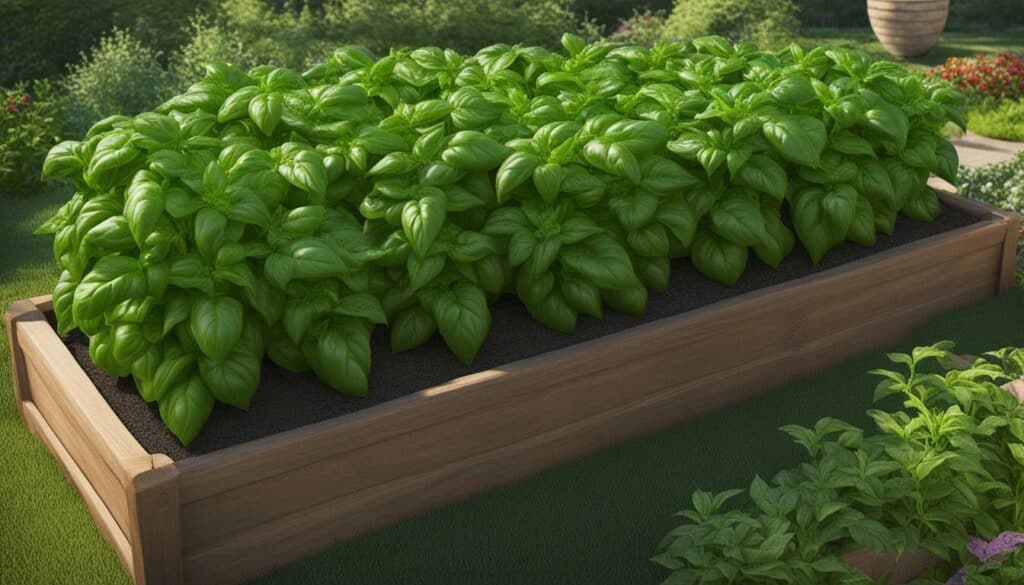
Basil and peppers make excellent companions in the garden, offering protection against pests and creating an ideal growing environment. Basil helps repel pests that commonly target peppers and also helps retain moisture and humidity, which peppers thrive in. Planting basil close to peppers can help ensure a successful and abundant harvest.
Root Vegetables
When basil is planted near root vegetables like beets, carrots, radishes, turnips, and parsnips, it provides valuable protection against damaging pests. Basil acts as a natural repellent, keeping pests away from the foliage and roots of these vegetables. This partnership contributes to healthier and pest-free root crops.
Marigolds
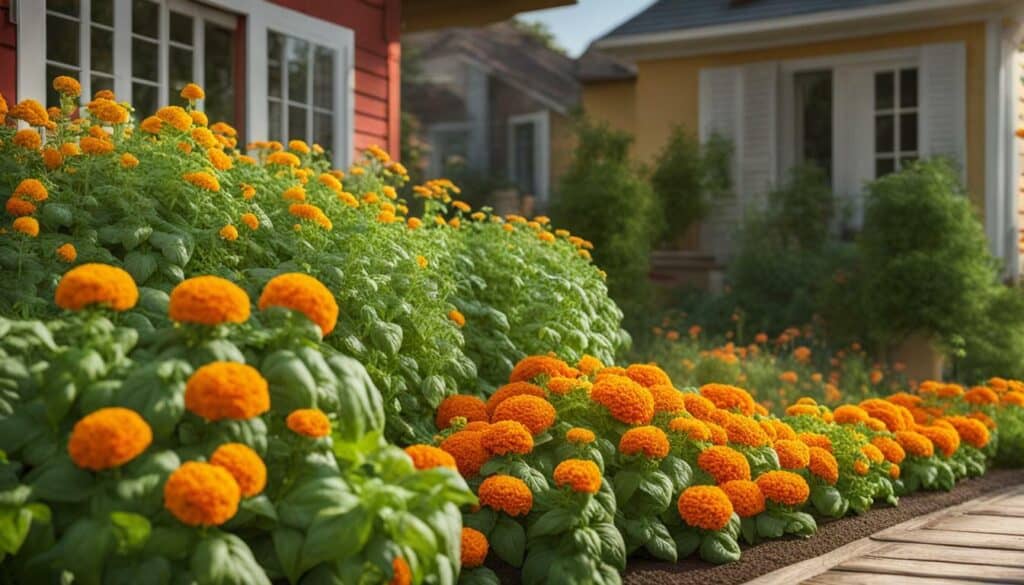
Basil and marigolds are a dynamic duo in the garden when it comes to pest control. Their combined aroma acts as a powerful deterrent for pests, providing an additional layer of protection for your plants. Planting basil and marigolds together creates a beautiful and functional garden bed that keeps unwanted pests at bay.
Borage
Borage is a beautiful flowering herb that pairs well with basil in the garden. Borage attracts beneficial insects like bees and predatory insects while also repelling pests. When planted alongside basil, borage enhances the flavor and growth of both plants, creating a thriving and productive garden.
Chives, Oregano, and Chamomile
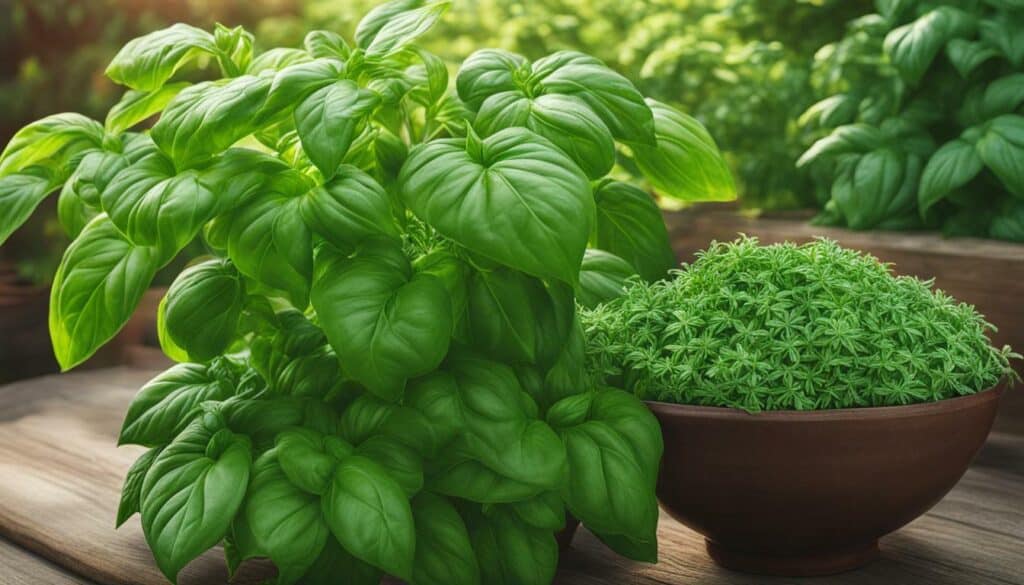
Herbaceous plants like chives, oregano, and chamomile make excellent companions for basil. These plants enjoy the presence of basil, which helps increase the potency of their essential oils. This partnership not only benefits the growth and flavor of the herbs but also attracts pollinators and other beneficial insects to the garden.
By incorporating these companion plants alongside basil in your garden, you can create a thriving and harmonious growing environment. These plant partnerships offer a range of benefits, from pest control to flavor enhancement, ensuring a successful and bountiful harvest.
Tips for Successful Companion Planting
To achieve optimal results with companion planting, it’s important to follow certain guidelines, such as strategically positioning tall and low-growing crops, incorporating herbs and flowers, and considering the specific needs of each companion plant. Here are some tips for successful companion planting:
- Plant tall crops on the north side of the garden and low-growing crops on the south side to ensure that all plants get enough sunlight.
- Plant root vegetables, such as potatoes and carrots, near fast-growing vegetables like beans or peas to make the most of limited space.
- Plant herbs and flowers with vegetables to help deter pests in your garden. For example, planting marigolds near tomatoes helps to repel aphids.
- Plant plants with similar nutrient needs together, such as cabbage and beets, which both need lots of nitrogen.
- Make sure you know which plants don’t get along before planting them near each other, like tomatoes and potatoes, which weaken each other’s growth.
- Plant companion plants in clusters to enhance their beneficial effects, such as planting different herbs and flowers together to attract pollinators and beneficial predators.
When you companion plant, the most important thing to remember is what the mature size of each of your plants will be. Make sure your plants have enough space between them so they can flourish without crowding each other out for resources. This will ensure that your plants can still get along and benefit each other.
Additional Tips for Successful Companion Planting
Here are a few more tips to help you have success with companion planting:
- Pair plants with similar watering needs together to ensure that all plants receive the right amount of moisture.
- Consider the growth habits of your companion plants and plan accordingly. For example, plant climbers like beans and cucumbers near trellises or fences to make the most of vertical space.
- Rotate your companion plants each year to prevent soil depletion and reduce the risk of pests and diseases building up in the same spot.
- Regularly monitor your garden for any signs of pests or diseases and take action promptly to prevent them from spreading.
- Experiment with different companion plant combinations to find what works best in your garden. Every garden is unique, and what works for one gardener may not work for another.
By following these tips and guidelines, you can create a harmonious and thriving garden where plants support and benefit each other, resulting in healthier plants, higher yields, and a more sustainable and eco-friendly gardening approach.
Companion Gardening with Basil: Unlocking the Benefits
Companion gardening with basil offers numerous benefits, including pest control, soil improvement, pollination support, and flavor enhancement, making it an essential practice for any garden enthusiast.
What is Companion Planting?
Companion planting is an age-old gardening technique that involves growing different plants together for mutual benefit. By strategically placing compatible plants in close proximity, gardeners can create a thriving ecosystem that promotes healthy growth and increased productivity. The practice of companion planting is based on the idea that certain plant combinations can enhance each other’s growth, deter pests, attract beneficial insects, and improve the overall health of the garden.
Repel Pests and Protect Your Crops
One of the key benefits of companion gardening with basil is its ability to repel pests and protect your crops. Basil has natural insecticidal properties that help deter pests such as cabbage worms, carrot flies, cucumber beetles, Mexican bean beetles, and cabbage moths. By planting basil alongside susceptible plants, you create a natural barrier that shields your valuable crops from damage and destruction.
Enhance Soil Nutrients
Companion planting with basil can also enhance soil nutrients and improve the overall health of your garden. Basil is known to release nutrients into the soil, particularly nitrogen, which is essential for plant growth. By planting basil alongside nutrient-hungry plants, such as tomatoes or peppers, you can replenish the soil and ensure your plants have access to the necessary nutrients for healthy development.
Attract Beneficial Insects
Basil is a powerful attractant for beneficial insects, such as bees and ladybugs, which play a crucial role in pollination and pest control. By incorporating basil into your garden, you can create an inviting environment that attracts these beneficial insects, increasing pollination rates and reducing pest populations. The presence of basil flowers provides nectar for beneficial insects, leading to improved biological control and a more balanced ecosystem in your garden.
Improve Taste and Growth
Companion planting with basil can improve the taste and growth of neighboring plants. Basil releases chemicals that promote accelerated growth and enhance the flavor of nearby vegetables. By planting basil alongside crops like tomatoes, peppers, or eggplants, you can experience more robust growth and enjoy a bountiful harvest with enhanced flavor.
Provide Shade and Keep Soil Cool
In addition to its pest-repelling and growth-enhancing properties, basil can provide shade and help regulate soil temperature. Taller plants, such as zucchini or asparagus, can serve as living shade tarps for sun-sensitive plants, ensuring they receive adequate protection from excessive heat. Low-growing companion plants like oregano can help keep the soil cool and retain moisture, benefiting the overall health and vitality of your garden.
Natural Weed Control
Companion planting with basil and other plants can also help control weeds. When companion plants are grown close together, they create dense foliage, leaving little room for weeds to sprout and compete for nutrients and space. By suppressing weed growth, companion plants like basil minimize the need for manual weeding and ensure that your garden remains weed-free and well-maintained.
How to Companion Plant with Basil
Successfully companion planting with basil requires careful planning and consideration. Researching plant compatibility, understanding growth habits, and following proper planting techniques are essential for maximizing the benefits of companion gardening. When companion planting with basil, ensure that plants are placed in close proximity, taking into account their mature size and nutrient requirements. Grouping compatible plants together and considering their individual needs will help create a harmonious and productive garden ecosystem.
Basil’s Best Plant Partners
When it comes to companion gardening, some plants make excellent partners for basil. Tomatoes, potatoes, asparagus, garlic, peppers, and various root vegetables are just a few examples of plants that thrive when planted alongside basil. These combinations not only enhance each other’s growth but also provide mutual benefits in terms of pest control, flavor enhancement, and overall garden health.
Tips for Successful Companion Planting
For successful companion planting, it’s important to keep a few key tips in mind. Plant tall crops on the north side of the garden to ensure all plants receive adequate sunlight. Pair root vegetables with fast-growing crops to maximize limited space. Intersperse herbs and flowers with vegetables to deter pests and attract beneficial insects. Consider the nutrient needs and growth habits of companion plants to ensure a harmonious planting arrangement.
Conclusion
In conclusion, companion gardening with basil offers a multitude of benefits for any garden enthusiast. From pest control to soil improvement, pollination support to flavor enhancement, basil proves to be a valuable ally in creating a thriving and sustainable garden. By harnessing the power of companion planting, you can unlock the full potential of your garden and enjoy a bountiful harvest year after year.
FAQ
Q: What is companion planting?
A: Companion planting is the practice of growing different plants together for mutual benefit. It involves planting specific plant species in close proximity to provide identifiable benefits, such as pest control, improved soil fertility, attracting beneficial insects, and more.
Q: What are the benefits of companion planting with basil?
A: Companion planting with basil can help repel pests, replenish soil nutrients, attract beneficial insects, improve taste and growth of neighboring plants, provide shade and keep soil cool, control weeds, and enhance the overall health and productivity of the garden.
Q: Which plants are good companions for basil?
A: Some of the best companion plants for basil include tomatoes, potatoes, asparagus, garlic, peppers, root vegetables, marigolds, borage, chives, oregano, chamomile, and many more. These plants provide various benefits such as pest control, flavor enhancement, pollination support, and nutrient improvement.
Q: How do I companion plant with basil?
A: To companion plant with basil, you should research and determine which plants enjoy each other’s company and have compatible growth habits. Plant them close to each other, ensuring they have enough space to thrive without overcrowding. Consider the specific needs of each plant, such as sunlight requirements and nutrient preferences.
Q: Are there any tips for successful companion planting?
A: Yes, here are some tips for successful companion planting: plant tall crops on the north side of the garden to ensure all plants get enough sunlight, plant herbs and flowers with vegetables to deter pests, group companion plants together to enhance their beneficial effects, and know which plants don’t get along to avoid planting them near each other.

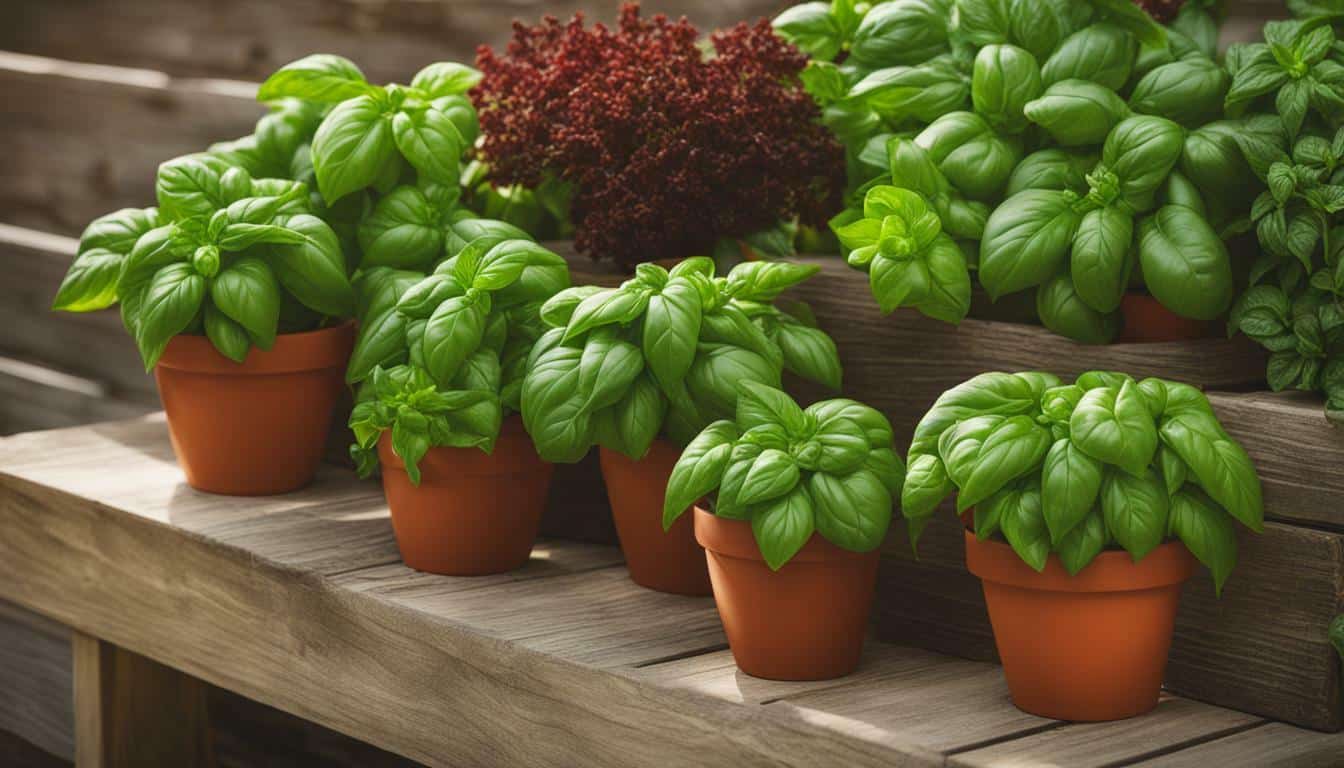



Leave a Reply